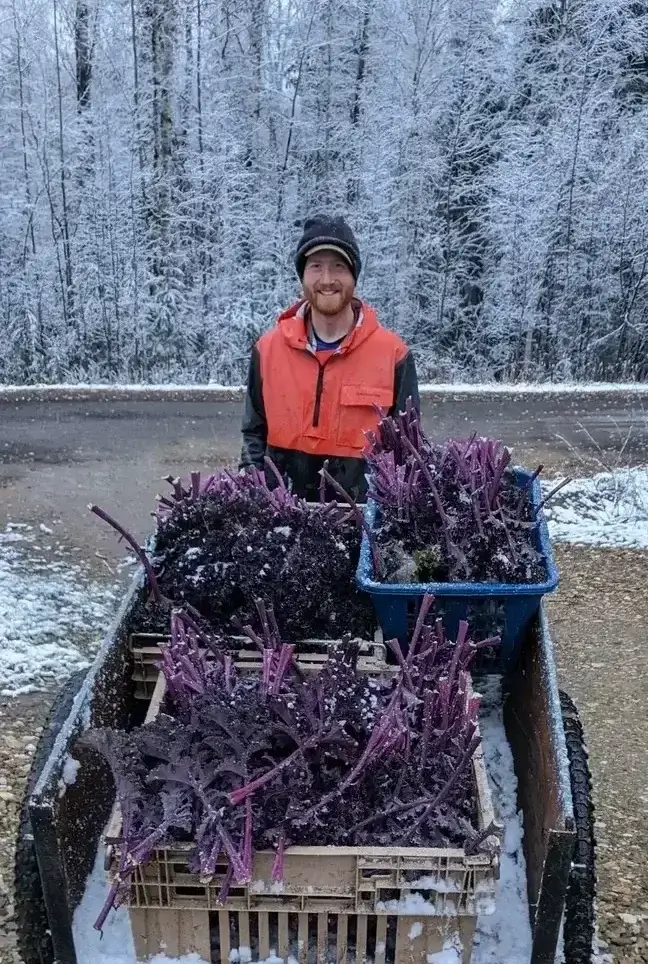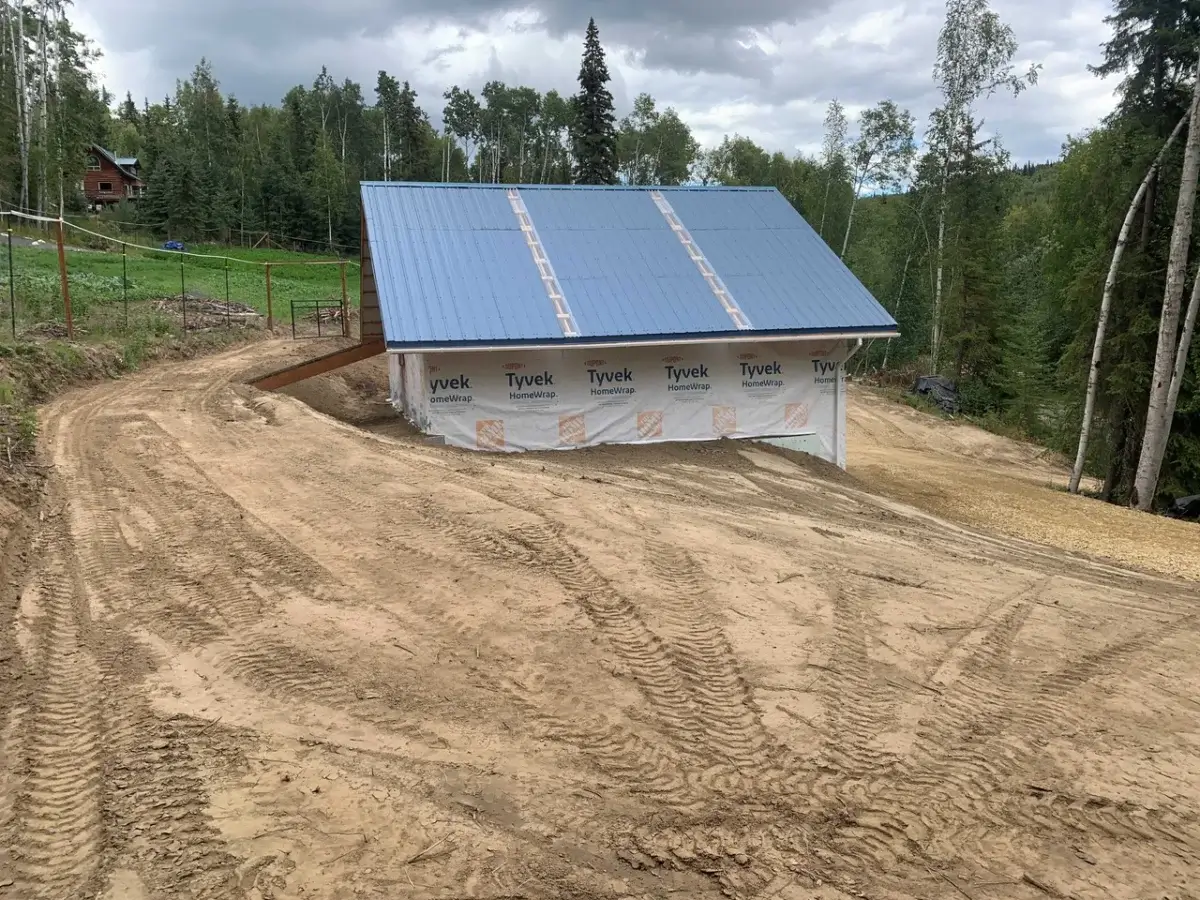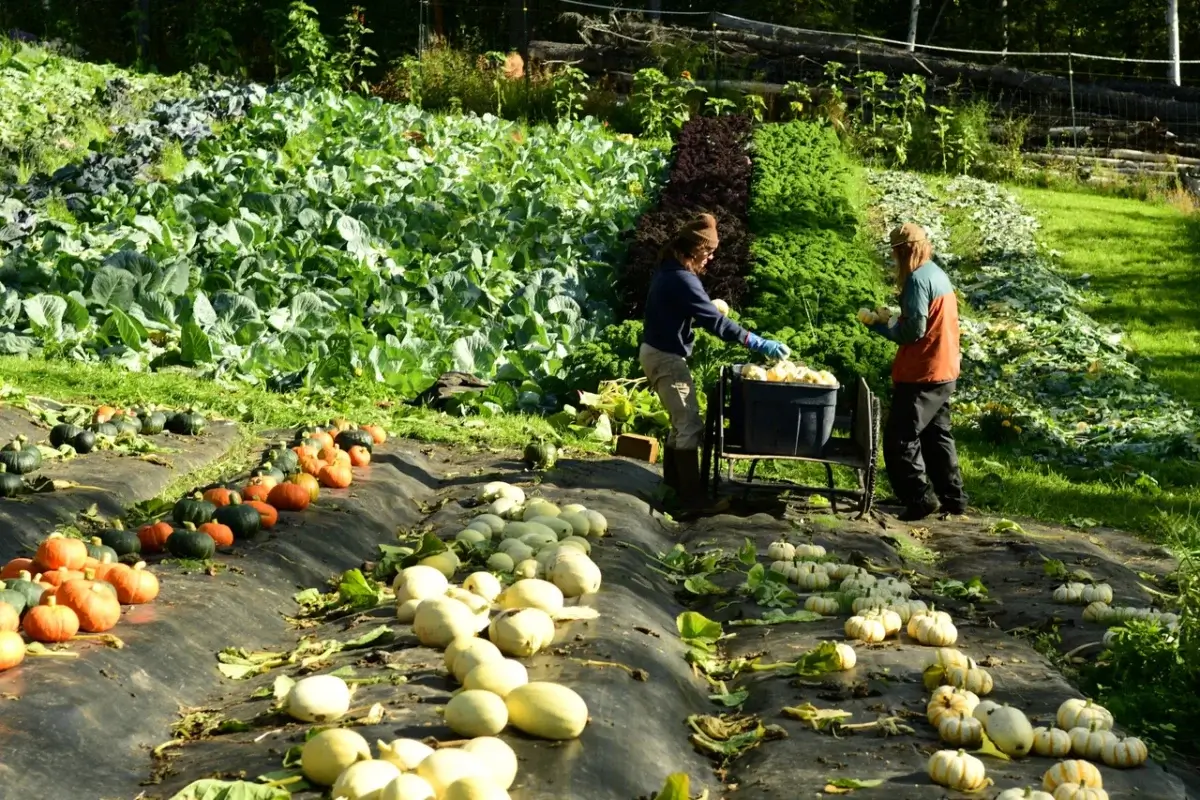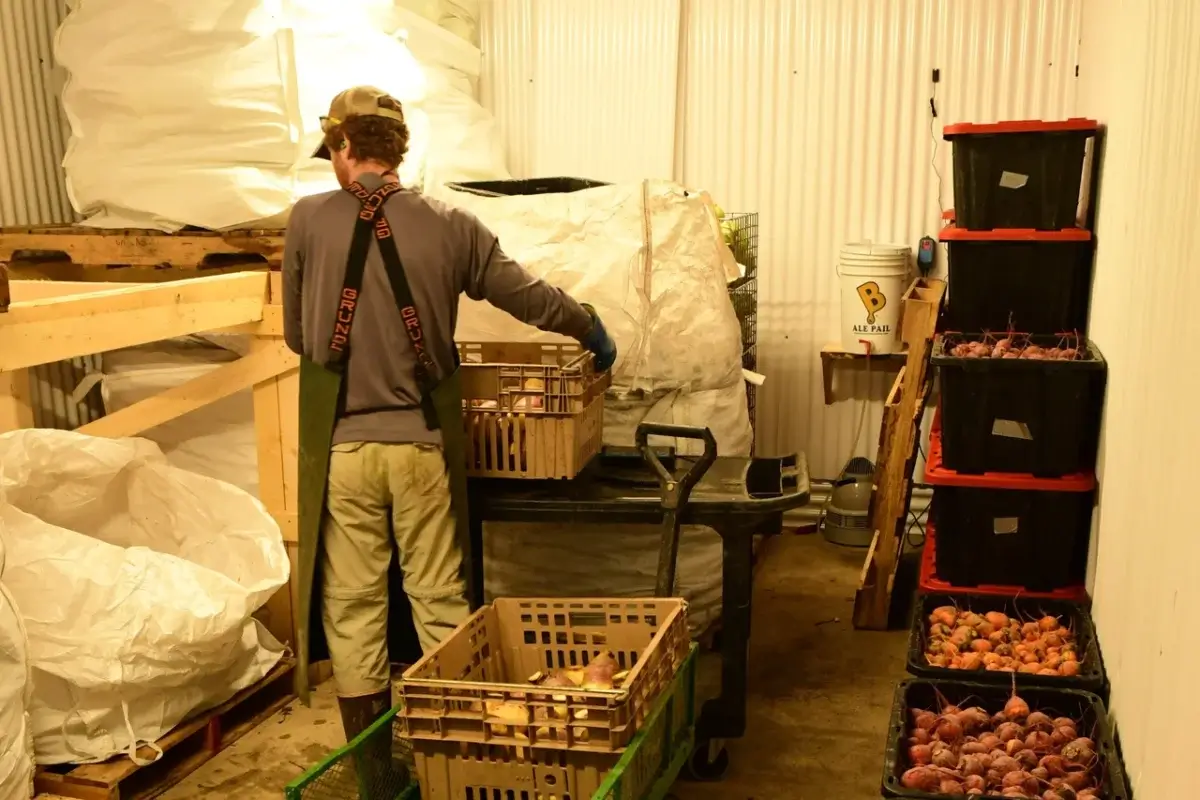Meet the Modern Farmer Cracking Cold Storage in the Coldest Places
An Alaska farmer demystifies affordable cold storage in his new book.
Meet the Modern Farmer Cracking Cold Storage in the Coldest Places
An Alaska farmer demystifies affordable cold storage in his new book.

Knapp with winter vegetables. Photography via Sam Knapp
In Fairbanks, Alaska, a radio advertisement from a local heat products store, The Woodway, says, “Fall is winter’s two-minute warning.” The growing season is short, from mid-May to mid-September, and it cuts straight to winter. You find the ground frozen by the first week of October. Temperatures eventually drop to -40 degrees Fahrenheit. During winter, the community is critically food insecure.
READ MORE
Find out why Alaskan farms can be out of reach for many new farmers.
When farmers in cold climates take a well-earned winter rest, their communities still want local produce. Grocery chains provide food through winter, shipping goods from across the world, but this is expensive and can weaken local self-reliance and food security. Having no local options makes a town more dependent on outside food sources that the community does not control, and it reduces the amount of dollars staying local. It also renders Fairbanks less food secure because, like other rural towns in cold climates, it is at the end of a long, tenuous supply chain with a high chance of disruption from too much snow on hundreds of miles of roads to shipping delays as seen during the COVID-19 pandemic. A lack of local produce during winter also means many farmers lose income from fall to spring.
Sam Knapp, a farmer in Fairbanks, has found a way to bridge that gap by building his own affordable, accessible cold storage. This has allowed him to sell his produce through one of the country’s harshest winters. He combines a science background with experience running his own farm, and after speaking with cold storage innovators across the country, he is sharing what he has learned in his new book, Beyond the Root Cellar.

Knapp has a B.S. in chemistry and physics. “My first job out of college was doing thermal modeling as an engineer. It is in my wheelhouse to think about heat transfer and phase change.” He then experimented with cold storage running a farm in Michigan. Knapp used Google Scholar to review studies on the storage needs of each vegetable he wanted to grow. For example, Knapp found that winter squash stores best after curing outside, which involves healing and hardening its rind, but curing will not happen in colder and wetter climates. To make up for uncontrollable wet and cold weather, Knapp introduced humidity control measures into his storage plans.
In 2020, Knapp moved to Fairbanks to start Offbeet Farm. There, he found farmers using root cellars and other cold storage techniques that were costeffective at temperatures well below zero degrees. But few farmers, if any, stored for more than a month or two. “Most farms here sell out by early September.”
So, Knapp set out to build a structure on his 1.5-acre farm that could store his produce through the entire winter, a time when temperatures drop to -40 degrees for weeks on end. The structure is 25 square feet, and looks like an ordinary outdoor shed, but it rests on specialized concrete forms that encase insulation and act as retaining walls. He now runs a successful over-winter Community Supported Agriculture (CSA) and sells his produce through March.
LEARN MORE
How solar-powered refrigerators could cool climate change.
“I built this building myself, and the total infrastructure cost was about $55,000. I have the capability of storing 35,000 to 40,000 pounds of produce.” With around 120 CSA customers, Knapp currently stores 25,000 pounds of produce, and he plans to expand each year.

Knapp says cold storage provides additional revenue streams and work-life balance; both are hard to come by for small farmers. “Farmers around here get half the year off, and they enjoy that, but their growing season is intense. It’s rough. It’s hard to make it through that time. I rarely feel burnt out from farming.” With cold storage, farmers do not have to harvest and sell all of their produce within the short growing season. It also helps balance self-care and family.

Storability varies by product: While Knapp has found that he and his customers are still eating their cabbage into the summer of the following growing year, storing his onions has proven tougher. He is still searching for an onion varietal that can store well after almost 24 hours of sunlight during the subarctic summer, followed by a cold and damp fall.
Every farmer experiments, and Knapp is no exception. He’s made some surprising discoveries. For instance, Knapp had not anticipated the warmth made by the vegetables themselves. After being picked, vegetables still respirate, (that is, metabolize carbohydrates), and produce heat as a byproduct—so much so that even when outside temperatures hit -10 degrees, Knapp has to cool the unit to lower the inside temperature down to 32 degrees. “This last winter, there was one time when it was -25 out, and my cooling fans were turning on.”

While Knapp is proud of his innovations, he still relies on more established farmers in the area for best practices in storing and selling produce at a commercial scale through a Fairbanks winter. “Half of it is hard research. The other half is talking to other farmers.” Building cold storage also comes with up-front investment and risk. “It seems very risky at the start, (to put) all this money down to get into it in the first place.”
To learn how others got over this risk and technical difficulty, Knapp interviewed cold-storage innovators from Winnipeg to North Carolina in Beyond the Root Cellar. It also shares practical know-how, ultimately showing that cold storage is within reach for all farmers. For example, readers learn that many farmers can take advantage of their existing summer storage facilities.
“Many people are primed to do this already,” he says. “You can start storing 3,000 to 5,000 pounds of produce by investing a couple thousand bucks just converting some space you already have.”
Never one to get ahead of himself, Knapp also points out that, in every interview, he heard the same touchstone: “Start small.” Knapps book, Beyond the Root Cellar, will be released November 14.
Follow us
This work is licensed under a Creative Commons Attribution-NoDerivatives 4.0 International License.
Want to republish a Modern Farmer story?
We are happy for Modern Farmer stories to be shared, and encourage you to republish our articles for your audience. When doing so, we ask that you follow these guidelines:
Please credit us and our writers
For the author byline, please use “Author Name, Modern Farmer.” At the top of our stories, if on the web, please include this text and link: “This story was originally published by Modern Farmer.”
Please make sure to include a link back to either our home page or the article URL.
At the bottom of the story, please include the following text:
“Modern Farmer is a nonprofit initiative dedicated to raising awareness and catalyzing action at the intersection of food, agriculture, and society. Read more at <link>Modern Farmer</link>.”
Use our widget
We’d like to be able to track our stories, so we ask that if you republish our content, you do so using our widget (located on the left hand side of the article). The HTML code has a built-in tracker that tells us the data and domain where the story was published, as well as view counts.
Check the image requirements
It’s your responsibility to confirm you're licensed to republish images in our articles. Some images, such as those from commercial providers, don't allow their images to be republished without permission or payment. Copyright terms are generally listed in the image caption and attribution. You are welcome to omit our images or substitute with your own. Charts and interactive graphics follow the same rules.
Don’t change too much. Or, ask us first.
Articles must be republished in their entirety. It’s okay to change references to time (“today” to “yesterday”) or location (“Iowa City, IA” to “here”). But please keep everything else the same.
If you feel strongly that a more material edit needs to be made, get in touch with us at [email protected]. We’re happy to discuss it with the original author, but we must have prior approval for changes before publication.
Special cases
Extracts. You may run the first few lines or paragraphs of the article and then say: “Read the full article at Modern Farmer” with a link back to the original article.
Quotes. You may quote authors provided you include a link back to the article URL.
Translations. These require writer approval. To inquire about translation of a Modern Farmer article, contact us at [email protected]
Signed consent / copyright release forms. These are not required, provided you are following these guidelines.
Print. Articles can be republished in print under these same rules, with the exception that you do not need to include the links.
Tag us
When sharing the story on social media, please tag us using the following: - Twitter (@ModFarm) - Facebook (@ModernFarmerMedia) - Instagram (@modfarm)
Use our content respectfully
Modern Farmer is a nonprofit and as such we share our content for free and in good faith in order to reach new audiences. Respectfully,
No selling ads against our stories. It’s okay to put our stories on pages with ads.
Don’t republish our material wholesale, or automatically; you need to select stories to be republished individually.
You have no rights to sell, license, syndicate, or otherwise represent yourself as the authorized owner of our material to any third parties. This means that you cannot actively publish or submit our work for syndication to third party platforms or apps like Apple News or Google News. We understand that publishers cannot fully control when certain third parties automatically summarize or crawl content from publishers’ own sites.
Keep in touch
We want to hear from you if you love Modern Farmer content, have a collaboration idea, or anything else to share. As a nonprofit outlet, we work in service of our community and are always open to comments, feedback, and ideas. Contact us at [email protected].by Clay Venetis, Modern Farmer
August 19, 2024
Modern Farmer Weekly
Solutions Hub
Innovations, ideas and inspiration. Actionable solutions for a resilient food system.
ExploreExplore other topics
Share With Us
We want to hear from Modern Farmer readers who have thoughtful commentary, actionable solutions, or helpful ideas to share.
SubmitNecessary cookies are absolutely essential for the website to function properly. This category only includes cookies that ensures basic functionalities and security features of the website. These cookies do not store any personal information.
Any cookies that may not be particularly necessary for the website to function and are used specifically to collect user personal data via analytics, ads, other embedded contents are termed as non-necessary cookies.